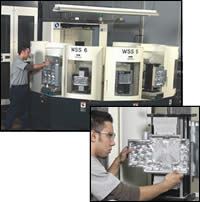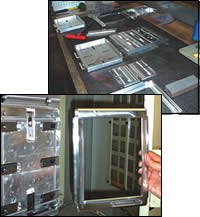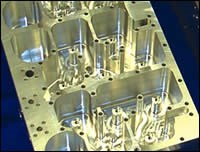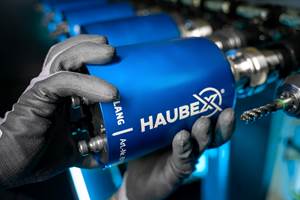Where Is Your Wiggle Room?
"Lights out" doesn’t require an intense commitment. This job shop achieves flexible unattended machining when it needs it using palletized HMCs.
Share





Job shops usually aren’t associated with lights-out production. Rather than high-mix, low-volume work, it is the opposite type of work—the low-mix, high-volume production of a captive plant—that usually lends itself to unattended processes.
SRPM is a 25-employee job shop in Solon, Ohio. Owners Mark Steinmeyer and Craig Steinmeyer say that most of their shop’s work does not lend itself to unattended production, either. However, SRPM has recognized that there are certain jobs, even in a job shop, that are appropriate for running lights-out. The discovery was almost accidental.
Now, the shop has learned to run unattended on its palletized horizontal machining centers just enough of the time. The machines run without attention sometimes a few hours per day, and sometimes just a few hours per week. Strategically applying this additional capacity has made SRPM even more effective at juggling urgent, short-run jobs while its employees are on-site. The small amount of unattended production provides essential “wiggle room” so that the shop can deal with surges in demand and get the best value from its small number of employees.
Why Wiggle?
Effective time management, speed and flexibility are staples at SRPM. Its success is contingent upon being an adept juggler at processing diverse jobs in the electronics, semi-conductor, power sports and communications sectors, usually in aluminum. To this day, brothers Mark and Craig embody the same ideals embraced by father Robert Steinmeyer when he founded the business in 1957. Continually updating equipment and adapting to evolving needs, the shop “goes where customers take it.” Often this journey involves evaluating operations and reevaluating ways of doing things.
“If I’m machining the same part 6 months from now in the same manner, then I’m not doing enough to improve the process,” says Gary Rivett, shopfloor manager at SRPM.
The 1990s brought about an influx of jobs from the telecom industry, a progression that, the company says, has created some scheduling challenges. Many of these customers, which include cell phone and other wireless device manufacturers, want JIT small batches and prototypes so they can get their latest designs out expeditiously. Compounding this urgency is the fact that prototypes may undergo various design changes mid-process. During the machining sequence for a given prototype, engineers might modify some aspect of the part design four or even five times. More often than not, a brand-new design could go through ten or 12 generations before it is ready for mass production. Because SRPM has to be extremely responsive to each crucial step in the process, the shop often has to halt production for another job mid-batch to run an urgent order. Accepting the “nature of the new” and the hurried pace that accompany it has paid off for the shop. In producing these rush orders accurately, it has been able to forge relationships with these customers, in turn generating new opportunities that have led to some long-range, higher-volume jobs. For instance, SRPM snagged a 2-year contract with a wireless device customer to create 25,000 pieces, quite a feat for a shop whose batch sizes usually hover around 50 or more.
Relatively early on, the Steinmeyers realized that in order to retain these high-profile jobs, they would need to rethink their operational standpoint. The capability to run these large batches efficiently was hindered by time lost setting up a JIT job or prototype job. Increasing requirements in terms of hogging out large amounts of aluminum while adhering to tight tolerances in the same pieces also meant that the company would need to acquire more equipment.
“We might take a 90-pound billet of aluminum and mill it down to 17 pounds,” Mark says. “Milling at such high speed generates an incredibly large volume of chips that our vertical machining centers just could not withstand. We also had to stop the machine and clean everything out frequently, which obviously disrupted operations.”
It was clear to SRPM that horizontal machining centers would represent a way to infuse a little “wiggle” and remove the “fuss” from fussy work. After purchasing several HMCs and braving some initial growing pains, the shop added two Makino a51 HMCs.
The machines’ center-trough design and base coolant wash system aid in chip evacuation, staving off chip accumulation that can clog up the work zone and damage way covers and other machine components.
Keeping Spindles Spinning
As more large-quantity orders made their way to the shop, SRPM was again at a crossroads. The inherent unpredictability of the shop’s work and the expanding array of jobs meant that the shop was still grappling with continual change-overs. Instead of spending energy creating clever fixturing solutions for complicated parts and carrying out other value-added duties, the shop’s most skilled and knowledgeable workers were virtually tethered to the stand-alone HMCs. Moreover, even with its capable equipment and trusty personnel running at full speed, the shop had to turn down some of these jobs because it didn’t have the capacity.
To augment its capabilities, and to better manage frequent setups, the shop acquired two more a51s from Makino—this time, outfitting them with eight 400-mm pallets. A cluster of eight pallets is arranged in a semicircle around each HMC. The rotary pallet distributor, which is situated in the center, grabs the pallet holding a finished part and pulls it from the machine, placing it in an empty work-set station. This occurs outside of the work zone as another piece is cutting. The HMC’s sequence enables the shop to machine continuously—the spindle doesn’t have to stop. During this virtually seamless sequence, operators have time to roam about the shop floor, accomplishing other tasks.
Cause For Celebration
In fact, the system comes in handy even when workers have left the building. In a roundabout way, the pallet system helped the Steinmeyers give its employees some R&R during the December 2005 holiday break. By setting up the pallet system to run completely unattended, the shop was able to complete a rush order without putting a damper on holiday plans.
“A key customer required a pre-production run of complex aluminum housings, each requiring several hours of machining,” Craig explains. “Our system technician loaded two parts and returned 6 hours later with complete confidence that all functions and machine safeguards would perform to expectations. The customer was very pleased, as were we.”
More Pliable Processes
Aside from the gift of some holiday relaxation, the pallet system has also given SRPM the flexibility to adapt more to its customer demands and adapt to its current workload. Whereas higher-volume projects are designated for processing on the stand-alones, short-run and prototype work can be efficiently machined on the palletized a51s. Operators can set up various short-run jobs on various pallets, leaving the pallet system to load the jobs in sequence and run them consecutively.
Typically, running this way creates 3- to 4-hour spurts of unattended processing, during which time employees can sketch out fixture solutions or perform parts inspection, entrusting that the machine will do what it is supposed to do. Perhaps most notably, SRPM’s skilled setup personnel, affectionately dubbed “bonafide setup engineers” can focus on what they do best.
Of course, set up is required of all jobs—whether they are intended for the palletized or stand-alone machines. A stand-alone HMC still cures the idle spindle problem. But the pallet systems can substantially reduce setups, thereby creating even more breathing room. Parts can be dedicated to pallets, allowing operators to swap out and load different parts easily. Simply loading up the rig, recalling the program and letting the machine run requires less of an investment of time and know-how on the part of the operator.
This freedom to dedicate parts, combined with the automatic tool changer, has also diminished the need for elaborate inspection procedures to hold accuracy. Certain that the correct tools are in place and that the correct parts have been correctly loaded, operators can worry more about the challenges of new parts. That is, they can work on designing custom fixturing approaches, including making plates, for tricky jobs such as the delicate, thin-walled aluminum components.
Another benefit of having a reliable pallet system, the company says, is that jobs can be set up accurately on first shift when the shop’s “setup engineers” and members of management are present. This ensures that the second shift starts swimmingly, with accurately fixtured parts ready to go. In fact, the second shift can run entirely different jobs, and the shop routinely staggers shifts to free up pockets of unattended production time.
“There have been times when SRPM has fulfilled JIT requirement, run production lot requirements and slipped in rush prototypes all in the same week,” Mark Steinmeyer says.
Making Palletization Palatable
The pallet systems incorporate a number of technologies that remove the fretting and guesswork from the shop’s machining equation. For instance, the shop opted for a Makino BTSOMA broken tool sensor and a 219-tool magazine when it purchased its latest a51. The “tool manager” in the machine’s control removes the potential for human errors when selecting tools. In addition, it essentially prevents “cutting air” if a tool should break and generates a report to alert management. Should a cutting tool fail, the system can pick a fresh tool so that cutting can continue. Via remote access, the Steinmeyers are attuned to the machine’s progress and are made aware of any unforeseen variables or programming glitches that might arise.
SRPM is proof that a adopting a low-key approach to unattended production can work well, even for job shops and even when dedicated lights-out production is not the ultimate goal. The shop has been able to parlay the sporadic leaps in productivity to increase revenues and better overall lead times. For shops that might see a similar level of unattended machining in their future, Mr. Steinmeyer has a couple of valuable pieces of advice. Foremost, have confidence in your staff. As many companies lament, creative individuals with an earnest interest in the business, a propensity toward analytical thinking and mechanical aptitude are difficult to come by. Once they are in the door, make it worth their while to stay and nurture their talents.
Second, don’t skimp on tooling capacity. What seems adequate now may not be in the future.
“I urge shops to avoid the pallet-pool mistake of underestimating tooling capacity,” Mark explains. “Our first palletized machine was equipped with 139 tools. Shortly after just 1 year, we realized that we needed more capacity. That led to purchasing a 219-tool magazine, ample capacity [or so we hope] to tackle even our most challenging parts.”
Related Content
Using the Toolchanger to Automate Production
Taking advantage of a feature that’s already on the machine tool, Lang’s Haubex system uses the toolchanger to move and store parts, making it an easy-to-use and cost-effective automation solution.
Read More3 Ways Artificial Intelligence Will Revolutionize Machine Shops
AI will become a tool to increase productivity in the same way that robotics has.
Read MoreFour-Axis Horizontal Machining Doubles Shop’s Productivity
Horizontal four-axis machining enabled McKenzie CNC to cut operations and cycle times for its high-mix, high-repeat work — more than doubling its throughput.
Read More4 Steps to a Cobot Culture: How Thyssenkrupp Bilstein Has Answered Staffing Shortages With Economical Automation
Safe, economical automation using collaborative robots can transform a manufacturing facility and overcome staffing shortfalls, but it takes additional investment and a systemized approach to automation in order to realize this change.
Read MoreRead Next
Registration Now Open for the Precision Machining Technology Show (PMTS) 2025
The precision machining industry’s premier event returns to Cleveland, OH, April 1-3.
Read MoreBuilding Out a Foundation for Student Machinists
Autodesk and Haas have teamed up to produce an introductory course for students that covers the basics of CAD, CAM and CNC while providing them with a portfolio part.
Read More5 Rules of Thumb for Buying CNC Machine Tools
Use these tips to carefully plan your machine tool purchases and to avoid regretting your decision later.
Read More






















.jpg;maxWidth=300;quality=90)









